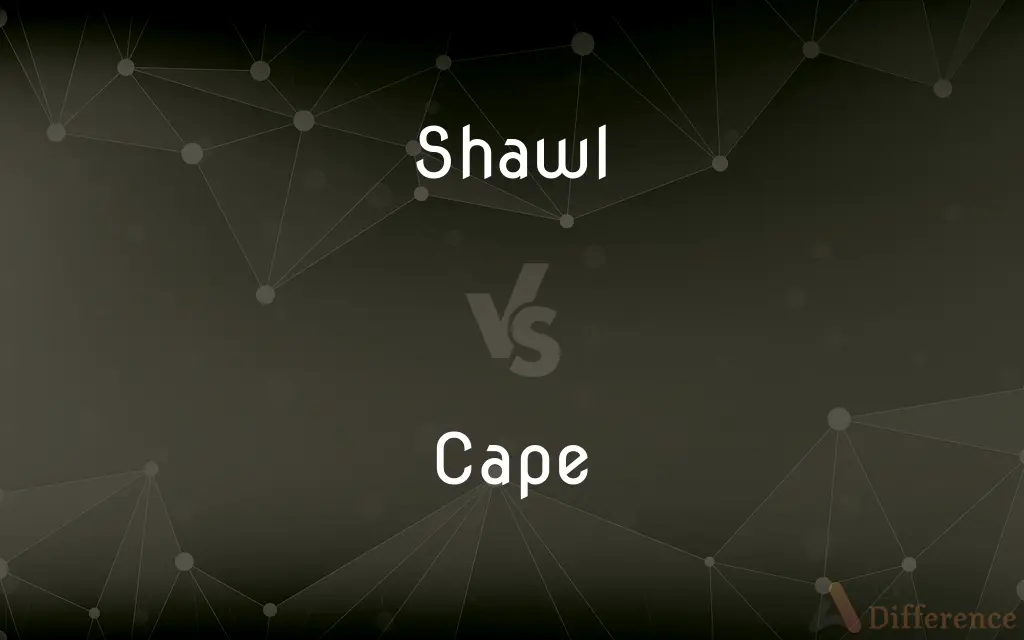Shawl vs. Cape — What's the Difference?
By Tayyaba Rehman & Fiza Rafique — Updated on April 30, 2024
A shawl is a piece of fabric worn around the shoulders or head for warmth or fashion, while a cape is a sleeveless outer garment that drapes the wearer’s back, arms, and chest.

Difference Between Shawl and Cape
Table of Contents
ADVERTISEMENT
Key Differences
A shawl is typically a simple, rectangular or triangular piece of cloth, often used to provide warmth and comfort around the neck and shoulders. On the other hand, a cape is designed as a more formal or stylish garment, often featuring a circular or oval cut that covers more of the body and can include decorative elements like collars, closures, or arm slits.
Shawls are often made from lightweight, woven materials such as wool, pashmina, or silk, making them ideal for both functional and decorative use. Whereas capes can be crafted from a variety of materials, including heavier fabrics like wool or velvet, tailored for both protection against the elements and as fashion statements.
The use of shawls is prevalent in many cultures around the world, often carrying significant cultural and traditional values, particularly in South Asia. In contrast, capes have been a recurring element in Western fashion and are frequently associated with certain professional or ceremonial roles, such as in academic or ecclesiastical attire.
Shawls can be draped in various styles, either loosely over the shoulders or wrapped tightly for added warmth. Capes, however, typically have a fixed style of wear, draped over the shoulders and fastening at the neck, offering a more dramatic and elegant appearance.
In terms of versatility, shawls are more adaptable as they can be folded or styled in multiple ways to suit different occasions, from casual wear to formal events. Capes, on the other hand, serve more as statement pieces in fashion, often worn as part of a specific look or for special occasions.
ADVERTISEMENT
Comparison Chart
Definition
A piece of fabric worn around the shoulders or head
A sleeveless outer garment that covers the back, arms, and chest
Material
Often lightweight like wool, silk
Can be made from heavier materials like wool or velvet
Cultural Significance
High in regions like South Asia
Common in Western fashion and certain professions
Style Variability
Highly versatile, can be styled variously
Less versatile, usually worn one way
Use
Casual and formal, more functional
More formal or ceremonial, often as a fashion statement
Compare with Definitions
Shawl
A traditional garment in many cultures.
During the festival, women wore traditional shawls with ethnic patterns.
Cape
A garment associated with certain iconic characters.
The superhero character is famous for his flowing blue cape.
Shawl
A wrap made from fabric worn around the shoulders or head.
She draped a colorful shawl over her shoulders during the chilly evening.
Cape
A protective garment against adverse weather.
She put on a waterproof cape to brave the stormy weather.
Shawl
An item used for warmth in cooler climates.
She always carried a woolen shawl in her bag in case it got cold.
Cape
A sleeveless outer garment that drapes the wearer's back, arms, and chest.
He wore a dark cape as part of his costume.
Shawl
A decorative accessory made from fine materials.
He gifted her a silk shawl embroidered with intricate designs.
Cape
A ceremonial or professional attire element.
The professor wore a traditional academic cape during the graduation ceremony.
Shawl
A versatile piece of clothing that can be styled in various ways.
For the wedding, she styled her shawl into a sophisticated wrap.
Cape
A fashion statement often seen in formal wear.
The actress arrived at the premiere wearing an elegant red cape.
Shawl
A shawl (from Persian: شال shāl, which may be from Hindi: दुशाला duśālā, ultimately from Sanskrit: शाटी śāṭī) is a simple item of clothing, loosely worn over the shoulders, upper body and arms, and sometimes also over the head. It is usually a rectangular or square piece of cloth, which is often folded to make a triangle, but can also be triangular in shape.
Cape
A sleeveless garment like a cloak but shorter
Shawl
A piece of fabric worn by women over the shoulders or head or wrapped round a baby.
Cape
A cape is a sleeveless outer garment which drapes the wearer's back, arms, and chest, and connects at the neck.
Shawl
A usually square, rectangular, or triangular piece of cloth worn as a covering for the head, neck, or shoulders.
Cape
A sleeveless cloak, typically a short one
He was wearing a flowing cape
Shawl
To cover with or as if with such a piece of cloth.
Cape
The pelt from the head and neck of an animal, for preparation as a hunting trophy
The hair on a cape for the taxidermist can spoil in warm weather
Shawl
A square or rectangular piece of cloth worn as a covering for the head, neck, and shoulders, typically by women.
She wears her shawl when it's cold outside.
Cape
A headland or promontory
We could see the island from the cape
Shawl
A fold of wrinkled flesh under the lips and neck of a bloodhound, used in scenting.
Cape
(in bullfighting) taunt (the bull) by flourishing a cape
The film shows a man expertly caping a charging bull
Shawl
(transitive) To wrap in a shawl.
Cape
Skin the head and neck of (an animal) to prepare a hunting trophy.
Shawl
A square or oblong cloth of wool, cotton, silk, or other textile or netted fabric, used, especially by women, as a loose covering for the neck and shoulders.
Cape
A sleeveless outer garment fastened at the throat and worn hanging over the shoulders.
Shawl
To wrap in a shawl.
Cape
A brightly colored cloth used in maneuvering the bull in a bullfight; a capote or muleta.
Shawl
Cloak consisting of an oblong piece of cloth used to cover the head and shoulders
Cape
A point or head of land projecting into a body of water.
Cape
To maneuver (the bull) by means of a cape in a bullfight.
Cape
(geography) A piece or point of land, extending beyond the adjacent coast into a sea or lake; a promontory; a headland.
Cape
A sleeveless garment or part of a garment, hanging from the neck over the back, arms, and shoulders.
Cape
(slang) A superhero.
Cape
To incite or attract (a bull) to charge a certain direction, by waving a cape.
Cape
(nautical) To head or point; to keep a course.
The ship capes southwest by south.
Cape
To skin an animal, particularly a deer.
Cape
To defend or praise, especially that which is unworthy.
Cape
(obsolete) To look for, search after.
Cape
To gaze or stare.
The captain just caped mindlessly into the distance as his ship was hit by volley after volley.
Cape
A piece or point of land, extending beyond the adjacent coast into the sea or a lake; a promontory; a headland.
Cape
A sleeveless garment or part of a garment, hanging from the neck over the back, arms, and shoulders, but not reaching below the hips. See Cloak.
Cape
To head or point; to keep a course; as, the ship capes southwest by south.
Cape
To gape.
Cape
A strip of land projecting into a body of water
Common Curiosities
Are capes suitable for everyday wear?
Capes are generally more suited for formal or special occasions rather than everyday wear.
How is a cape different from other outer garments?
Unlike other outer garments, a cape is sleeveless and covers the back, arms, and chest without armholes.
What is the primary function of a shawl?
Shawls are primarily used for warmth and as fashion accessories.
What materials are commonly used to make shawls?
Shawls are commonly made from materials like wool, silk, and pashmina.
Can shawls be used in formal attire?
Yes, shawls can be elegantly incorporated into formal attire.
How should one choose between a shawl and a cape for an event?
The choice depends on the formality of the event, the overall outfit, and personal style preferences.
Are there any iconic figures or movies associated with capes?
Yes, capes are often associated with iconic figures like superheroes and characters in period dramas.
Do capes offer versatility in styling?
Capes offer less styling versatility compared to shawls and are typically worn in a standard draped fashion.
What are some typical uses of shawls beyond fashion?
Beyond fashion, shawls are used for prayer, rituals, or as comfort objects in many cultures.
What type of closures are found on capes?
Capes may feature various closures such as ties, buttons, or clasps at the neck.
Is there a cultural significance to wearing shawls?
Yes, shawls hold significant cultural value in many regions, particularly in South Asia.
How do weather conditions affect the choice between a shawl and a cape?
Shawls are more adaptable to various weather conditions, while capes are best suited for colder or more formal settings.
What is the historical significance of capes?
Historically, capes have been used in military and religious attire and as part of traditional folk costumes.
What are some modern trends involving shawls and capes?
Modern trends include blending traditional designs with contemporary fashion, using sustainable materials, and innovative ways of draping.
Share Your Discovery

Previous Comparison
Adenovirus vs. Retrovirus
Next Comparison
Bioreactor vs. FermentorAuthor Spotlight
Written by
Tayyaba RehmanTayyaba Rehman is a distinguished writer, currently serving as a primary contributor to askdifference.com. As a researcher in semantics and etymology, Tayyaba's passion for the complexity of languages and their distinctions has found a perfect home on the platform. Tayyaba delves into the intricacies of language, distinguishing between commonly confused words and phrases, thereby providing clarity for readers worldwide.
Co-written by
Fiza RafiqueFiza Rafique is a skilled content writer at AskDifference.com, where she meticulously refines and enhances written pieces. Drawing from her vast editorial expertise, Fiza ensures clarity, accuracy, and precision in every article. Passionate about language, she continually seeks to elevate the quality of content for readers worldwide.
















































